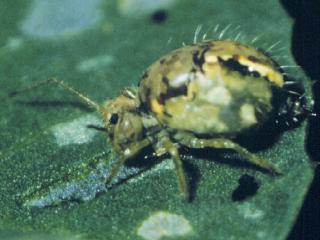Growers and consultants are urged to monitor for lucerne flea and mites
- Wongan Hills
- Beverley
- Brookton
- Popanyinning
A consultant has found brown wheat mites in a two leaf lupin crop east of Wongan Hills.

DPIRD staff have recently found high numbers of redlegged earth mites (RLEM) and blue oat mites in grassy roadside weeds in the Beverley, Brookton and Popanyinning areas, indicating that they have hatched in the area from over-summering eggs. Although there are few germinated crops visible in these areas crops and pastures that are present may be at risk, as well as crops that will germinate following future rainfall events.
Very few lucerne flea were found indicating that the main egg hatching event has perhaps not occurred yet because the good soaking rains, which are required for these eggs to hatch, have yet to occur.
RLEM have a requirement of cool daytime temperatures (below at least 20C for 7-10 days) before these ‘diapause’ eggs hatch. If mites are not present on foliage, inspect the soil also - only a small proportion of RLEM populations feed on foliage at any one time, with the large majority remaining on the soil surface.
Mite feeding causes silvering or white discoloration of leaves and distortion or shrivelling in severe infestations. Affected seedlings can die at emergence with high mite populations.
Growers should be mindful of regularly checking germinating crops and pastures in the coming weeks and there is risk of crop damage even where insecticides had been applied pre-sowing or post sowing prior to emergence.
Last year many growers were caught out with high levels of lucerne flea damaging crops in June and July because the hatching of eggs was delayed probably beyond the window of insecticide residual activity. It is likely that the coming rains (fingers crossed) will initiate a larger hatching of lucerne flea.
Management of lucerne flea and mites
Insecticides will not kill RLEM eggs so it should not be assumed that a pre-sowing insecticide application has killed all mites that could be present during crop germination.
With the recent variation of the Pegasus® (diafenthiuron, group 12A) insecticide label to include the control of RLEM in canola, growers now have access to another chemical mode of action group. Pegasus® can be applied to canola from the cotyledon stage when thresholds are reached, with no more than two applications per crop. The withholding period for Pegasus® is 11 weeks, so it is best suited for early season control.
Blue oat mites are mostly controlled with the same chemical and rates used against redlegged earth mite.
Lucerne flea have a high natural tolerance to synthetic pyrethroids so avoid insecticides from this group.
For more insecticide information refer to DPIRD’s 2019 Autumn/Winter Insecticide Guide.
Free RLEM insecticide resistance testing available in 2019
RLEM surveys for resistance will again be undertaken in 2019 for WA properties. DPIRD is particularly interested in testing mites from any properties with synthetic pyrethroid (SP) and omethoate spray failures. To enquire and arrange for resistance testing contact entomologist Svetlana Micic, Albany DPIRD on +61 (0)8 9892 8591.
Growers and consultants are urged to apply integrated pest management (IPM) strategies when managing RLEM. These strategies include; identifying mites, rotating different chemical groups and reserving co-formulations or chemical mixtures only for situations where damaging levels of RLEM and other insect pests are present. For more IPM information see DPIRD’s Prevent redlegged earth mite resistance page and GRDC’s Resistance management strategy for the red legged earth mite in Australian grains and pastures fact sheet.
For more information about diagnosing and managing mites and lucerne flea refer to the departments;
- Diagnosing blue oat mite
- Diagnosing brown wheat mite
- Diagnosing redlegged earth mite
- Diagnosing lucerne flea pages.
For more information contact Dustin Severtson, Development Officer, Northam on +61 (0)8 9690 2160 or Svetlana Micic, Research Officer, Albany on +61 (0)8 9892 8591.

